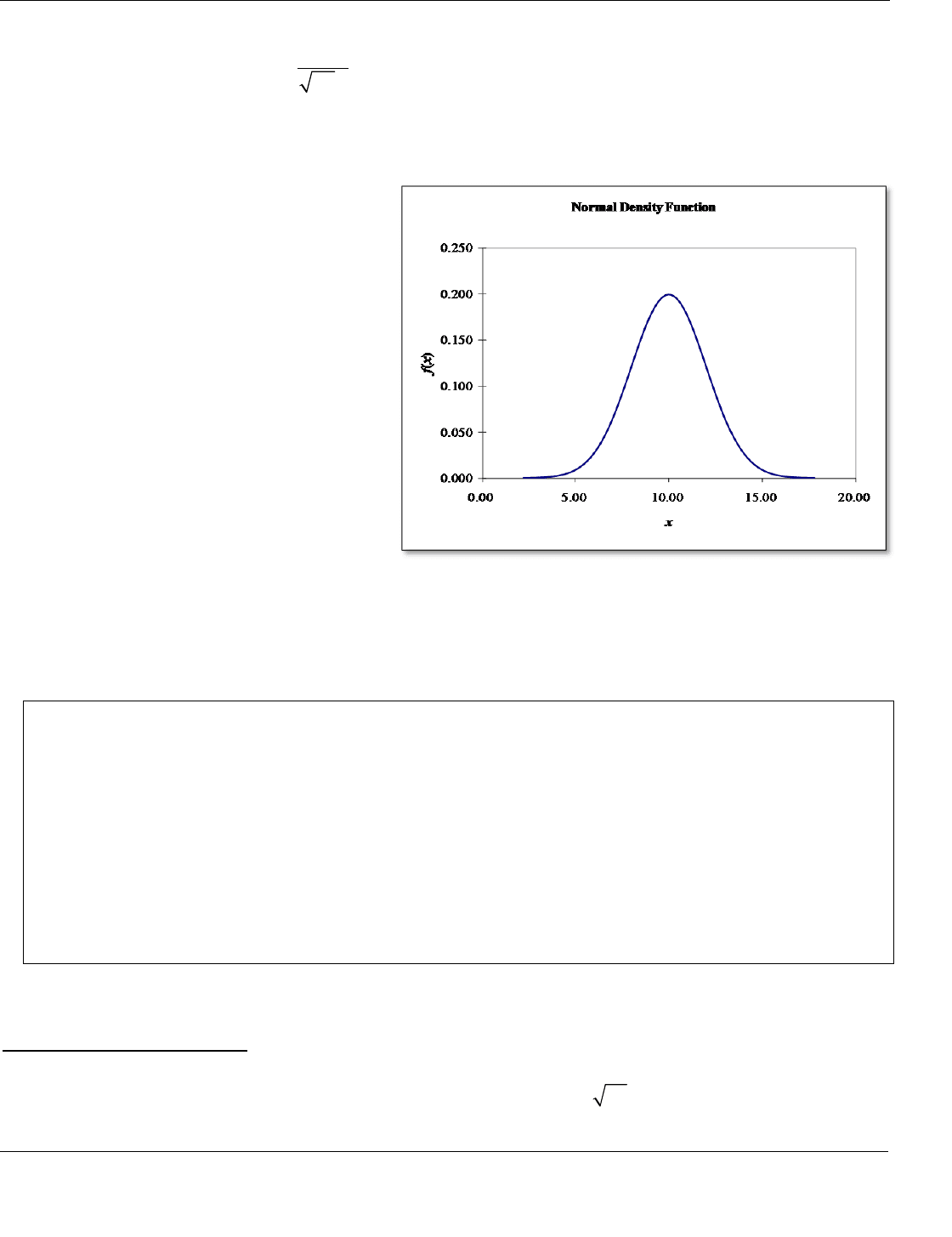Hill A.V. The Encyclopedia of Operations Management: A Field Manual and Glossary of Operations Management Terms and Concepts
Подождите немного. Документ загружается.


ptg6843605
newsvendor problem – Nominal Group Technique (NGT)
The Encyclopedia of Operations Management Page 236
decisions. These contexts all have the same problem structure: a single policy parameter, such as the order
quantity, the presence of random demand, and known unit overage and unit underage costs.
The newsvendor model is fundamental to solving many important operations problems. The intuition
obtained from the model can also be helpful. Explicitly defining the over-buying and under-buying cost and
calculating the critical ratio can lead managers and analysts to better decisions.
The optimal order quantity is the demand associated with the critical ratio (also called the critical fractile),
which is R = c
u
/(c
u
+ c
o
), where c
u
is the cost of having one unit less than the realized demand, and c
o
is the unit
cost of having one unit more than the realized demand. In the simplest retail environment, c
u
is price minus unit
cost (the gross margin), and c
o
is unit cost minus salvage value. The optimal order quantity is Q* = F
−1
(R),
where F
−1
(R) is the inverse of the cumulative distribution function evaluated at the critical ratio.
For example, a grocery store owner needs to buy newspapers every Monday. If the owner buys one
newspaper more than the demand, the store loses the cost of the newspaper (c
o
= unit cost = $0.10). If the owner
buys one newspaper less than the demand, the store loses the margin on the newspaper (c
u
= unit price – unit cost
= $0.50 – $0.10 = $0.40). The critical ratio, therefore, is R = c
u
/(c
u
+ c
o
) = 0.4/(0.4 + 0.1) = 90%, and the optimal
order quantity is at the 90th percentile of the cumulative demand distribution (CDF).
For the normal distribution, the Excel function for the optimal order quantity is NORMINV(critical ratio,
mean, standard deviation). For example, if we have a newsvendor problem with normally distributed demand
with a mean of 4 units, a standard deviation of 1 unit, and costs c
o
= $100 and c
u
= $1000, the critical ratio is
R = 0.91, and the optimal order quantity is Q* = NORMINV(0.91, 4, 1) = 5.34 units.
See anchoring, bathtub curve, capacity, fractile, Poisson distribution, purchasing, safety stock, seasonality,
slow moving inventory, stockout, triangular distribution.
newsvendor problem – See newsvendor model.
Newton’s method – An important numerical method for “finding the roots” of the function; also known as the
Newton-Raphson iteration.
The roots of a function ( )
f
x are the x values where ( ) 0f x
. Newton’s method uses the Newton step
1
( ) / '( )
k
k k k
x
x f x f x
to find a better x value with each iteration. For “well-behaved” functions, Newton’s
method usually converges very quickly, usually within five to ten steps. However, the choice of the starting
point x
0
is important to the speed of convergence. The method will converge when /
df dx and
2 2
/d f dx
do not
change signs between x
0
and the root of ( ) 0f x
. Cheney and Kincaid (1994) identified three possible
situations where Newton’s procedure will not converge. These are the runaway problem, the flat spot problem,
and the cycle problem.
See linear programming (LP), operations research (OR).
NGT – See Nominal Group Technique (NGT).
no fault receiving – A way of inventory accounting used in retailing where store employees are only required to
“count boxes” and put the items away; employees are not required to account for the item count in each box.
See receiving.
nominal capacity – See capacity.
Nominal Group Technique (NGT) – A planning tool that helps a group organize and prioritize issues and gain
buy-in through the process.
Originally developed as an organizational planning technique by Delbecq, Van de Ven, and Gustafson in
1971, the nominal group technique can be used as an alternative to both the focus group and the Delphi
techniques. It presents more structure than the focus group, but still takes advantage of the synergy created by
group participants. The NGT helps build agreement on the issues in the process. This author uses the following
approach for facilitating NGT brainstorming sessions:
1. Prepare – The leader in the organization should define the main question, find a skilled facilitator, select a
group of participants, instruct the participants to come prepared to address the main question, arrange for a
room with some empty walls, get marking pens (to make it hard for people to write too small) and Post-it
Notes (at least 20 per participant). The 3M lined 4x6 Super-Sticky Post-it Notes work well.

ptg6843605
nominal scale
−
normal distribution
Page 237 The Encyclopedia of Operations Management
2. Kickoff
– The facilitator should open the meeting by clearly defining the main question (e.g., “How can we
reduce waiting times for our customers?”) and the scope of the discussion (e.g., “Our scope will not include
information system issues.”). The facilitator should this question on the whiteboard or easel and then ask the
participants if they have any questions about the main question or scope before beginning.
3. Generate
– Participants should then spend about five to ten minutes thinking
quietly and creatively about the main question and generating a number of
ideas to address the question. (In this author’s experience, very few
workgroups are disciplined enough to prepare their notes before the meeting.)
Each participant should write each idea on a separate Post-it Note, with a one-
to five word title in very large (one-inch high) letters on the top half of the
note. Notes must be readable from the other side of the room. The facilitator
should instruct participants to put their markers down when done. The
facilitator should move on to the next step when about three quarters of the
participants have their markers down.
4. Share
– Each participant is asked to share just one note for each round. The
facilitator should add each note to the wall, trying to group them logically.
For smaller groups, it works well to have everyone stand at the wall during
this process. Discussion is not allowed during this time, except to ask short clarification questions.
Participants should share their duplicate notes first and then add one new idea (note) to the wall. Participants
should feel free to pass and then jump back in if they think of other contributions. The process should
continue around the room until all notes are on the wall.
5. Group
– The facilitator should ask for two or three volunteers to come to the wall and organize the notes
into groups while other participants take a short break.
6. Regroup
– When people return from break, they should come to the wall and study the groups. They can
move a note from one group to another, combine two or more groups, add a new group, add new notes, and
make copies of notes that belong to more than one group.
7. Arrange
– With help from the participants, the facilitator should arrange groups in logical order on the wall
(e.g., time order or in some sort of hierarchy). Some groups might become subgroups of larger groups. This
process may require additional title notes.
8. Vote
– Each participant should vote on the top three groups he or she believes is worthy of further discussion
and action. (The facilitator should only allow two votes per person if the number of groups is less than four.)
9. Assign
– Organizing the ideas into groups and prioritizing them is usually just the starting point. It is now
necessary to determine the next steps. It is important to decide who has ownership for a particular issue or
solution and to clearly define the next steps for that person. In some cases, it is also a good idea to begin to
create a formal project to address the top issues.
Advantages of the NGT process over typical brainstorming include:
• Shows respect for all participants and their ideas.
• Does not allow “high-verbal” or “high-control” participants to dominate the discussion.
• Collects many ideas from the participants along with detailed documentation of these ideas.
• Efficiently creates a set of notes to document the ideas using the participants’ own words.
• Very quickly and efficiently groups and prioritizes ideas.
• Results in good solutions.
• Creates a shared understanding of the problems and the solutions.
• Builds a strong sense of ownership of the results.
See affinity diagram, brainstorming, causal map, focus group, ideation, impact wheel, issue log, Kepner-
Tregoe Model, KJ Method, parking lot, Root Cause Analysis (RCA), seven tools of quality.
nominal scale – See scales of measurement.
non-instantaneous replenishment – See instantaneous replenishment.
normal distribution – A continuous probability distribution commonly used to model errors (for both forecasting
and regression models) and also for the sum of many independent random variables.
Parameters:
Mean
and standard deviation
.
MONDAY
STAFFING

ptg6843605
normal distribution
–
normal distribution
The Encyclopedia of Operations Management Page 238
Density and distribution functions:
The density function for the normal distribution has a bell shape and is
written mathematically as
2 2
( ) /(2 )
1
( )
2
x
f x
e
. The distribution function is the integral of the density
function and has no closed form, but is tabulated in many books.
Statistics:
Range (–∞,∞), mean (
) = mode = median, variance (
2
). The inflection points for the density
function are at
. The standard normal distribution has mean 0
and standard deviation
1
.
Graph:
The graph on the right is the
normal probability density function (PDF)
with 10
and
2
.
Parameter estimation:
The sample
mean and standard deviation are unbiased
estimators of
and
.
Excel:
In Excel, the standard normal
distribution function evaluated at z is
NORMSDIST(z). This is the probability that
a standard normal random variable will be
less than or equal to z. Excel normal density
and distribution functions are NORMDIST(x,
μ, σ, FALSE) and NORMDIST(x, μ, σ,
TRUE). NORMINV(p, μ, σ) is the inverse
distribution function, which returns the value
of x that has cumulative probability p. Excel
2010 renames the functions as NORM.DIST,
NORM.S.DIST, NORM.INV, and
NORM.S.INV, but continue to use the same parameters.
Excel simulation:
In an Excel simulation, normally distributed random variates can be generated by the
inverse transform method with x = NORMINV(1-RAND(), μ, σ). Another approach, based on the central limit
theorem, is to sum 12 random numbers. The sum minus 12 is approximately standard normal. The Box-Muller
method is a special-purpose approach for generating independent normal random deviates from a stream of
random numbers and is more efficient and precise than other methods. The Box-Muller VBA code follows:
Function normal_rv_bm(mu, sigma) as double
Const twopi As Double = 6.28318530717959
Dim ncall As Long, u1 As Double, u2 As Double, z As Double, z2 As Double
ncall = ncall + 1
If ncall Mod 2 <> 0 Then
u1 = Rnd(): u2 = Rnd()
z = Sqr(-2 * Log(u1)) * Cos(twopi * u2): z2 = Sqr(-2 * Log(u1)) * Sin(twopi * u2)
Else
z = z2
End If
normal_rv_bm = z * sigma + mu
End Function
Approximation for F(z):
The following VBA code is an accurate approximation for the standard normal
distribution function based on the algorithm in Press et al. (2002)
34
. The author compared this approximation to
NORMSDIST(z) for z in the range [−6, 6] and found a maximum absolute deviation of 7.45061x10
-8
at z = 0.72.
34
This is algorithm 26.2.17 from Abramowitz and Stegun (1964), which claims a maximum absolute error < 7.5·10
−8
.
The VBA
implementation above increases the number of significant digits for the
2 1/ 2c
parameter and uses the “if-then”
condition provided in Press but not in Abramowitz and Stegun.

ptg6843605
normal time − numeric-analytic location model
Page 239 The Encyclopedia of Operations Management
Function normsdistF(z As Double) As Double
Const c2 = 0.398942280401433, p = 0.2316419, b1 = 0.31938153, b2 = -0.356563782
Const b3 = 1.781477937, b4 = -1.821255978, b5 = 1.330274429: Dim t As Double, b0 As Double
t = 1 / (1 + p * Abs(z)): b0 = c2 * Exp((-z) * (z / 2))
normsdistF = 1 - b0 * ((((b5 * t + b4) * t + b3) * t + b2) * t + b1) * t
If z < 0 Then normsdistF = 1 - normsdistF
End Function
Approximation for the inverse distribution function F
-1
(p): The following is an approximation for the
inverse of the standard normal distribution function: x = F
–1
(p) ≈ 5.06329114(p
0.135
– (1 – p)
0.135
) or in Excel
=5.06329114*(p ^0.135-(1-p)^0.135). This approximation was tested in Excel in the range p = (0.50400,
0.99997) and was found to have a maximum absolute percent error of 4.68% at p = 0.99997. For p in the range
(0.504, 0.9987), the maximum absolute percent error was 0.67% at p = 0.10. Computer code for the inverse
normal with a relative absolute error less than 1.15 x 10
–9
for x = F
–1
(p) ≥ –38 can be found at
http://home.online.no/~pjacklam/notes/invnorm (April 7, 2011).
See binomial distribution, central limit theorem, confidence interval, error function, inverse transform
method, lognormal distribution, probability density function, probability distribution, random number, sampling,
Student’s t distribution.
normal time – A work measurement term from the field of industrial engineering used for the time to complete a
task as observed from a time study, adjusted for the performance rating.
The steps in estimating a normal time are as follows:
1. Compute the average task time for each operator – Collect several random observations on task times,
and compute the average observed task time
i
t
for each operator i.
2. Estimate the performance rating for each operator – Make subjective estimates of the performance rating
(r
i
) for each operator i, where r
i
= 1.10 for someone working 10% faster than normal.
3. Calculate the standard time – Calculate the standard time as the product of the allowance (A) and the
average observed times adjusted by the performance ratings (r
i
), i.e.,
1
1
(1 )
N
s
td i i
i
T A r t
N
. The allowance
(A) is for personal needs, fatigue, and unavoidable delays. The allowance should depend on work
environment issues, such as temperature, dust, dirt, fumes, noise, and vibration and is usually about 15%.
See performance rating, standard time, time study, work measurement, work sampling.
normalization – An information systems term for the process of reducing redundancies and anomalies in a
database; once normalization is done, the database is said to be normalized.
See data warehouse.
North American Free Trade Agreement (NAFTA) – An agreement that formed a free trade area between the
U.S., Canada, and Mexico. It went into effect on January 1, 1994.
np-chart – A statistical process control chart used to monitor the number of non-conforming units in a sample.
The np-chart is similar to a p-chart. The only major difference is that the np-chart uses count data rather than
proportions. The control limits are typically set at
3 (1 )np np p
, where p is the estimate of the long-term
process mean. The np-chart plots the number of non-conforming units.
See control chart, p-chart, Poisson distribution, Statistical Process Control (SPC).
NPD – See New Product Development (NPD).
numerically controlled (NC) machine – See Computer Numerically Controlled (CNC) machine.
numeric-analytic location model – An iterative method that guarantees the optimal solution to the single facility
infinite set location problem.
A firm needs to locate a single warehouse to serve n customers. Each customer (j) has coordinates (x
j
, y
j
),
demand or weight (w
j
), and a transportation cost of c
j
per unit per mile. The single warehouse facility is to be
located at the coordinates
0 0
( , )
x
y
. The travel distance from the warehouse to customer j is assumed to be

ptg6843605
objective function – offshoring
The Encyclopedia of Operations Management Page 240
Pythagorean (straight-line) distance defined by
2 2
0 0
( ) ( )
j j j
d x x y y
. The goal is to find the
0 0
( , )
x
y
coordinates for the warehouse that minimize the total incremental cost (TIC) defined as
n
j j j
j
TIC c w d
. The
center-of-gravity solution for this problem is
0
1
n
j j j
j
x
c w x
and
0
1
n
j j j
j
y c w y
. This solution is sometimes
called the “center of mass” or “centroid.” Although the center-of-gravity method is quite simple, it is not
necessarily optimal and can be far from optimal.
See center-of-gravity model for facility location, facility location, gravity model for competitive retail store
location, great circle distance, logistics, marginal cost, Pythagorean Theorem, warehouse.
O
objective function – See linear programming.
obsolescence – See obsolete inventory.
obsolete inventory – Inventory that can no longer be sold because of lack of market demand, outdated technology,
degradation of quality, or spoilage; also called “dead and excess” inventory and “dead stock.”
Most firms try to remove obsolete inventory to free up space and take a tax write-off earlier rather than later.
Firms often use simple rules to determine if inventory is dead. These rules are usually based on how much time
has passed with no sales. Some firms, particularly retailers, can “clear” nearly obsolete inventory by selling it at
a discounted price. Gupta, Hill, and Bouzdine-Chameeva (2006) presented a pricing model for clearing end-of-
season retail inventory. Most firms have a financial reserve for obsolete inventory based on sales, current
inventory investment, age, historical trends, and anticipated events.
See ABC classification, all-time demand, carrying charge, red tag, shrinkage, slow moving inventory,
termination date.
OC curve – See operating characteristic curve.
Occam’s Razor – A principle in science and philosophy that recommends selecting the competing hypothesis that
makes the fewest assumptions; also called the law of parsimony; also spelled Ockham’s Razor.
This principle is interpreted to mean that the simplest of two or more competing theories is preferable and
that an explanation for unknown phenomena should first be attempted in terms of what is already known.
See KISS principle, parsimony.
Occupational Safety and Health Administration (OSHA) – A U.S. government agency created by the
Occupational Safety and Health Act of 1970 to ensure safe and healthful working conditions for working men
and women by setting and enforcing standards and by providing training, outreach, education and assistance.
OSHA is part of the U.S.Department of Labor. The administrator for OSHA is the assistant secretary of
labor for occupational safety and health. OSHA’s administrator answers to the secretary of labor, who is a
member of the cabinet of the president of the United States.
See DuPont STOP, error proofing, risk management, safety.
Ockham’s Razor – See Occam’s Razor.
OCR – See Optical Character Recognition (OCR).
ODM (Original Design Manufacturer) – See contract manufacturer.
OEE – See Overall Equipment Effectiveness.
OEM (Original Equipment Manufacturer) – See original equipment manufacturer.
off-line setup – See setup reduction.
offshoring – Developing a supplier in another country with either vertically integrated or external suppliers.
Whereas outsourcing refers to the use of another party regardless of that party’s location, offshoring refers
to the location of the source of supply. A firm could offshore and own the offshore vertically integrated supplier.

ptg6843605
one-minute manager − on-time delivery (OTD)
Page 241 The Encyclopedia of Operations Management
The primary issues that should be considered in an offshore decision include (1) expertise in managing
remote locations, (2) quality of the workforce, (3) cost of labor, (4) language skills, (5) telecom bandwidth, (6)
cost and reliability, (7) infrastructure, (8) political stability, (9) enforceability of intellectual property rights and
business contracts, (10) general maturity of the business environment, and (11) risk related to weather
(earthquakes, hurricanes, tornadoes, typhoons, and volcanoes).
See expatriate, intellectual property (IP), landed cost, nearshoring, operations strategy, outsourcing, supply
chain management.
one-minute manager – A simple managerial coaching concept that involves three one-minute interactions
between a manager and an employee.
The One Minute Manager (Blanchard & Johnson 1982) presented three simple ways for managers to
interact with their subordinates – goal setting, praise, and reprimand. All three of these interactions require about
one minute, though the time may vary based on the situation. The main point is that these three interactions can
and should be short, simple, and regular. These three interactions are briefly described below:
One-minute goal setting – One-minute managers regularly ask employees to review their goals with a script
such as, “What are your goals for this month?” This process helps the manager and employees confirm that they
are in complete agreement on goals and priorities.
One-minute praise – When one-minute managers catch their employees doing something right, they give
their employees immediate praise and tell them specifically what they did right. Just saying “good job” is not
specific. After giving a praise, the manager should pause for a moment to allow the employee to feel good and
then remind the employee how his or her actions help the organization. The managers should finish by shaking
hands and encouraging the employee to keep up the good work.
One-minute reprimand – One-minute managers provide immediate, specific, and clear feedback to
employees. The goal of the reprimand is not to punish, but rather to help employees better achieve their goals.
Following a reprimand, the manager should shake hands and remind the employee that he or she is important and
that it was the employee’s behavior that did not meet the standard.
The three one-minute interactions are closely interrelated. One-minute goal setting clarifies goals, one-
minute praise reinforces behavior consistent with the goals, and one-minute reprimand gives negative feedback
for behavior inconsistent with the goals.
See management by walking around, SMART goals.
one-piece flow – A lean manufacturing practice of making only one part at a time (a batch size of one) before
moving the part to the next step in the process; also called single-piece flow, make-one-move-one, and one-for-
one replenishment.
This lean ideal is not always achievable. Single Minute Exchange of Dies and other setup time reduction
methods are critical for helping organizations reduce setup cost (and ordering cost) and move toward this ideal.
See batch-and-queue, continuous flow, lean thinking, setup time reduction methods, Single Minute Exchange
of Dies (SMED), zero inventory.
on-hand inventory – The quantity shown in the inventory records as being physically in the inventory.
Whereas on-hand inventory is the current physical quantity in stock, the inventory position is the quantity on-
hand plus on-order, less allocated, less backordered.
See allocated inventory, backorder, cycle counting, inventory management, inventory position, Master
Production Schedule (MPS), Materials Requirements Planning (MRP), on-order inventory, open order,
perpetual inventory system.
on-order inventory – The amount of inventory that has been ordered from a supplier (internal or external) but not
yet received.
The inventory position is the quantity on-hand, plus on-order, less allocated, less backordered.
See inventory management, inventory position, Master Production Schedule (MPS), Materials Requirements
Planning (MRP), on-hand inventory, open order, perpetual inventory system.
on-the-job training (OJT) – A method for training employees by involving them in the work.
Workers develop skills simply by working, ideally under the watchful eye of a supervisor or mentor, and
usually during the normal workday.
See cross-training, human resources, job design.

ptg6843605
on-time and complete – operations management (OM)
The Encyclopedia of Operations Management Page 242
on-time and complete – See on-time delivery.
on-time delivery (OTD) – A customer delivery/service metric that is measured as the percentage of orders
received by the promised date (within an allowable time window); also known as on-time and complete.
See blanket purchase order (PO), dispatching rules, operations performance metrics, service level, supplier
scorecard, Transportation Management System (TMS).
open-book management – Sharing key financial information openly with employees and other stakeholders.
The phrase “open-book management” was coined by John Case of Inc. Magazine in 1993 (Aggarwal &
Simkins 2001) to describe the practice of providing employees with all relevant information about their
company’s financial performance. Some firms take it a step further and share financial information with
customers and suppliers. In this author’s experience, this concept is rarely used in North America.
See stakeholder.
open order – An order sent to a supplier (either internal or external) but not yet received by the customer; also
called a scheduled receipt.
When an order is sent to a supplier, it is said to be released. Open orders are included in the inventory
position (but not the on-hand balance) and used with both internal and external suppliers. The on-order balance
for an item is the sum of the order quantities for all open orders for that item.
See bullwhip effect, Business Requirements Planning (BRP), inventory position, net requirements, on-hand
inventory, on-order inventory.
operating characteristic curve – A graphical approach for understanding the parameters of a lot acceptance
sampling plan.
The operating characteristic curve (OC) plots the probability of accepting a lot on the y-axis and the lot
fraction or percent defectives on the x-axis.
See acceptance sampling, consumer’s risk, producer’s risk, quality management, sampling, Statistical
Process Control (SPC), Statistical Quality Control (SQC).
operation – (1) In a general context: Any manufacturing or service process, no matter how large or small. (2) In a
Materials Requirements Planning (MRP) or shop floor control context: A specific step in the routing required to
make an item.
In the MRP context, the routing specifies the sequence of operations required to make an item. Each
operation is defined by the operation sequence number, the workcenter, required materials, standard setup time,
and standard run time per part.
See dispatching rules, operations management (OM), routing, shop floor control.
operation overlapping – See transfer batch.
operations management (OM) – Management of the transformation process that converts labor, capital,
materials, information, and other inputs into products and services for customers.
Operations management is a core subject taught in all business schools, along with accounting, finance,
marketing, human resources, management information systems, and general management/strategy. The preface
of this encyclopedia presents a framework for operations management. Many colleges and universities are now
using the broader term “supply chain and operations management.”
The operations management framework below was developed through an extensive survey of operations
management professors and practitioners (Hays, Bouzdine-Chameeva, Meyer Goldstein, Hill, & Scavarda 2007).
(The figure below is an adaption of that framework.) An organization’s operations strategy is derived from its
business strategy and should guide and inform decisions in the four “pillars” of operations management: product
& process design, capacity & demand management, supply chain management, and process improvement. These
four pillars are supported by quality and people management, systems management, analytical tools, and
performance metrics. All terms in this framework are presented in detail elsewhere in this encyclopedia.

ptg6843605
operations performance metrics − operations performance metrics
Page 243 The Encyclopedia of Operations Management
The operations management profession is supported by many academic and professional societies, including:
• American Society for Quality (ASQ), www.asq.org
• APICS - The Association for Operations Management, www.apics.org
• Association for Manufacturing Excellence (AME), www.ame.org
• Council of Supply Chain Management Professionals (CSCMP), www.cscmp.org
• Decision Sciences Institute (DSI), www.decisionsciences.org
• European Operations Management Association (EurOMA), www.euroma-online.org
• Institute for Operations Research and the Management Sciences (INFORMS), www.informs.org
• Institute for Supply Management (ISM), www.ism.ws
• Institute of Industrial Engineers (IIE), www.iienet2.org
• International Federation of Operational Research Societies (IFORS), www.ifors.org
• Lean Enterprise Institute (LEI)
35
, www.lean.org
• Manufacturing and Service Operations Management Society (MSOM), http://msom.society.informs.org
• Operational Research Society, www.orsoc.org.uk
• Production and Operations Management Society (POMS), www.poms.org
• Project Management Institute (PMI), www.pmi.org
• Society of Manufacturing Engineers (SME), www.sme.org
• Supply Chain Council (SCC)
36
, www.supply-chain.org
A short description for each of these societies is presented in this encyclopedia. This list omits many other
important professional societies in related disciplines inside and outside North America.
See American Society for Quality (ASQ), APICS (The Association for Operations Management), Association
for Manufacturing Excellence (AME), Council of Supply Chain Management Professionals (CSCMP), Decision
Sciences Institute (DSI), European Operations Management Association (EurOMA), human resources, Institute
for Operations Research and the Management Sciences (INFORMS), Institute for Supply Management (ISM),
Institute of Industrial Engineers (IIE), Manufacturing and Service Operations Management Society (MSOM),
operation, operations research (OR), operations strategy, Production Operations Management Society (POMS),
Project Management Institute (PMI), Society of Manufacturing Engineers (SME), Supply Chain Council.
operations performance metrics – Variables used to evaluate any process.
As noted in the balanced scorecard entry, it is important that the performance metrics be balanced. One way
to balance metrics is to use both financial and operations performance metrics. Operations performance metrics
are often the key means for achieving the financial performance metrics, because the operations performance
metrics usually “drive” the financial metrics.
35
Like the other organizations in this list, LEI is a non-profit; however, it is not a professional society like the others.
36
The Supply Chain Council is closely identified with the SCOR model.
Quality & people management
Systems management
Performance metrics
Product &
process design
Supply
chain
management
Process
improvement
Capacity &
demand
management
Analytical tools
Source: Professor Arthur V. Hill
Operations strategy
Operations management framework

ptg6843605
operations performance metrics – operations performance metrics
The Encyclopedia of Operations Management Page 244
With respect to operations performance metrics, many firms have at least one metric in each of these three
categories: better (quality related metrics), faster (time and flexibility related metrics), and cheaper (cost
related metrics). Many operations experts argue that the cheaper metrics are improved by improving the better
and faster metrics. This author has added stronger as a fourth category of metrics to include risk management
and strategic alignment. Many operations performance metrics are used in practice. This encyclopedia provides
clear definitions for nearly all of the following operations performance metrics:
Better metrics:
Product performance metrics – These depend on the specific product (e.g., the specifications for an
automobile will define how long it takes to accelerate from 0 to 60 miles per hour).
Customer satisfaction and loyalty metrics – Customer satisfaction, intention to repurchase (willingness to
return), willingness to recommend, Net Promoter Score (NPS), Customer Effort Score (CES), and actual
customer loyalty.
Process capability and performance metrics and quality metrics – Yield, defects, defects per million
units, defects per million opportunities, parts per million, rolled throughput yield, sigma level metric, process
capability (C
p
), process capability index (C
pk
), process performance (P
p
), and the process performance index
(P
pk
).
Service related metrics – Service level, cycle service level, unit fill rate, order fill rate, line fill rate, perfect
order fill rate, on-time delivery (OTD), percent on-time and complete, average response time, premium
freight, stockout cost, and shortage cost.
Faster metrics:
Time metrics – Cycle time
37
, order to cash cycle time, throughput time, customer leadtime, time to market,
average wait time, average time in system, Mean Time to Repair (MTTR), Mean Time Between Failure
(MTBF).
Learning rate metrics – Learning rate (learning curve), half-life, and percent improvement.
Theory of Constraints metrics – Inventory Dollar Days (IDD), Throughput Dollar Days (TDD), and
Throughput dollars.
Lean metrics – Value added ratio (also called manufacturing cycle effectiveness)
38
.
Cheaper metrics:
Inventory metrics – Inventory turnover, periods supply (days on-hand), inventory investment, and inventory
carrying cost.
Forecast error metrics – Mean Absolute Percent Error (MAPE), Mean Absolute Scaled Error (MASE),
bias, and forecast attainment.
Equipment metrics – Utilization, availability, downtime, first-pass yield, Mean Time Between Failure
(MTBF), Mean Time to Repair (MTTR), and Overall Equipment Effectiveness (OEE).
Traditional cost accounting metrics – Productivity (output/input), efficiency (standard time)/(actual time),
utilization, sales, gross margin, overhead variance (fixed and variable), labor variance, labor efficiency
variance, direct material variance, direct material price variance, and cost per part.
Warehouse metrics – First pick ratio, inventory accuracy, capacity utilization, cube utilization, mispicks.
Transportation metrics – Freight cost per unit shipped, outbound freight costs as percentage of net sales,
inbound freight costs as percentage of purchases, average transit time, claims as percentage of freight costs,
freight bill accuracy, percent of truckload capacity utilized, average truck turnaround time, on-time pickups.
Stronger metrics:
Strategic alignment – Gap between goals and performance on highest level strategic performance metrics.
Risk assessment metrics – Risk priority number (in the context of an FMEA), expected loss, probability of
failure.
Safety metrics – Number of days since last injury, number of serious accidents per time period, number of
near misses, time to fix safety issues.
37
This term has multiple meanings. See the cycle time entry for more details.
38
Lean could be classified as “better” (because it reduces defects), “faster” (because it reduces cycle time), and “cheaper”
(because it reduces waste and cost). The same is true for several other types of metrics.

ptg6843605
operations research (OR) − operations strategy
Page 245 The Encyclopedia of Operations Management
Triple bottom line metrics – People (human capital) metrics, planet (natural capital) metrics, and profit
(economic benefit for all stakeholders) metrics.
See balanced scorecard, benchmarking, Capability Maturity Model (CMM), cube utilization, Customer
Effort Score (CES), cycle time, dashboard, Data Envelopment Analysis (DEA), downtime, efficiency, Failure
Mode and Effects Analysis (FMEA), financial performance metrics, first pick ratio, forecast error metrics, half-
life curve, Inventory Dollar Days (IDD), inventory turnover, Key Performance Indicator (KPI), learning curve,
learning organization, Net Promoter Score (NPS), on-time delivery (OTD), Overall Equipment Effectiveness
(OEE), performance management system, process capability and performance, productivity, queuing theory,
robust, sand cone model, scales of measurement, service level, service management, sigma level, standard time,
strategy map, supplier scorecard, Throughput Dollar Days (TDD), utilization, wait time, work measurement,
yield, Y-tree.
operations research (OR) – The science that applies mathematical and computer science tools to support decision
making.
Operations research (OR) draws on many mathematical disciplines, such as optimization, statistics,
stochastic processes (queuing theory), decision theory, simulation, graph theory (network optimization), and
game theory. Optimization can be further broken down into constrained and unconstrained optimization, each of
which can be broken down further into linear, non-linear, and discrete optimization. Simulation appears to be a
field of growing importance with a number of powerful software tools, such as Arena, that are available for
creating complex stochastic models of real-world systems.
During its formative years shortly after World War II, OR professionals argued that OR projects should be
multi-disciplinary. However, most OR people today are trained as mathematicians, computer scientists, or
industrial engineers. OR is considered by most experts to be synonymous with management science. The largest
professional organization for operations research is INFORMS (www.informs.org).
See algorithm, assignment problem, decision tree, genetic algorithm, heuristic, Institute for Operations
Research and the Management Sciences (INFORMS), knapsack problem, linear programming (LP),
Manufacturing and Service Operations Management Society (MSOM), mixed integer programming (MIP),
network optimization, Newton’s method, operations management (OM), optimization, sensitivity analysis,
simulated annealing, simulation, transportation problem, transshipment problem, Traveling Salesperson
Problem (TSP).
operations strategy – A set of policies for using the firm’s resources to support the business unit’s strategy to gain
competitive advantage; also called manufacturing strategy.
Operations objectives – Operations strategy is usually defined in terms of the operations objectives of cost,
quality, flexibility, and service. Other variants of this list also include delivery (instead of service), time or speed
(as a part of service or flexibility), and customization (as a type of flexibility). Some lists also include safety,
sustainability, environmental issues, and development of human capital. The Andersen Corporation Menomonie
plant uses safety, quality, delivery, cost, and morale. This encycleopedia uses better, faster, cheaper, and
stronger, where stronger means more robust and better aligned with strategy.
Trade-offs – Firms can often gain competitive advantage by making the best tradeoffs and by avoiding
trade-offs between operations objectives. For example, Dell Computer was able to “change the rules of the
game” and gain competitive advantage by being the first to successfully offer low cost assemble-to-order
customized computers through direct mail (providing customization and quality without cost). Similarly, FedEx
was one of the first to offer reliable overnight package delivery at a reasonable price (providing reliable fast
delivery at a reasonable price).
Explicit versus implicit – The operations strategy may be explicit or implicit. An implicit strategy is not
written down, and senior executives may not be able to articulate it, but it becomes apparent with an objective
evaluation of the management’s consistent approach to decision making and the firm’s position in the market.
Operations strategy process versus content – Researchers in the operations management field often make
a distinction between the operations strategy process and content. The process is the methodology that the
organization uses to create its operations strategy, whereas the content is the substance of the strategy.
Structure versus infrastructure decisions – The most effective operations organization is not necessarily
the one that has the maximum efficiency, responsiveness, or flexibility, but rather the one that best fits the
